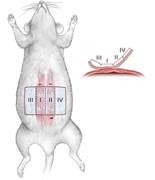Room 2 (Henry B. Gonzalez Convention Center)
Sunday, November 3, 2002
8:00 AM - 4:00 PM
Room 2 (Henry B. Gonzalez Convention Center)
Monday, November 4, 2002
8:00 AM - 4:00 PM
Room 2 (Henry B. Gonzalez Convention Center)
Tuesday, November 5, 2002
8:00 AM - 4:00 PM
Room 2 (Henry B. Gonzalez Convention Center)
Wednesday, November 6, 2002
8:00 AM - 4:00 PM
311
P10 - Basic Fibroblast Growth Factor (B-FGF) Expression and Flap Viability Following Surgical Delay of a Rat Transverse Rectus Abdominis Myocutaneous (Tram) Flap
| Delay | Zones | |||
| (Days) | I | II | III | IV |
| 0 | 41.3+16.2 | 61.3+19.4 | 27.2+11.3 | 24.1+15.0 |
| 7 | 93.2+15.1 | 88.2+15.2 | 86.1+14.5 | 94.0+15.3 |
| 14 | 93.8+10.5 | 94.5+10.4 | 75.5+5.9 | 77.5+11.1 |
| 21 | 75.9+11.2 | 66.0+8.2* | 77.3+8.7 | 79.2+11.3 |

 Background: Partial TRAM flap loss in breast reconstruction can be a devastating complication. Surgical delay of the TRAM flaps has been shown to improve its viability.
Background: Partial TRAM flap loss in breast reconstruction can be a devastating complication. Surgical delay of the TRAM flaps has been shown to improve its viability.